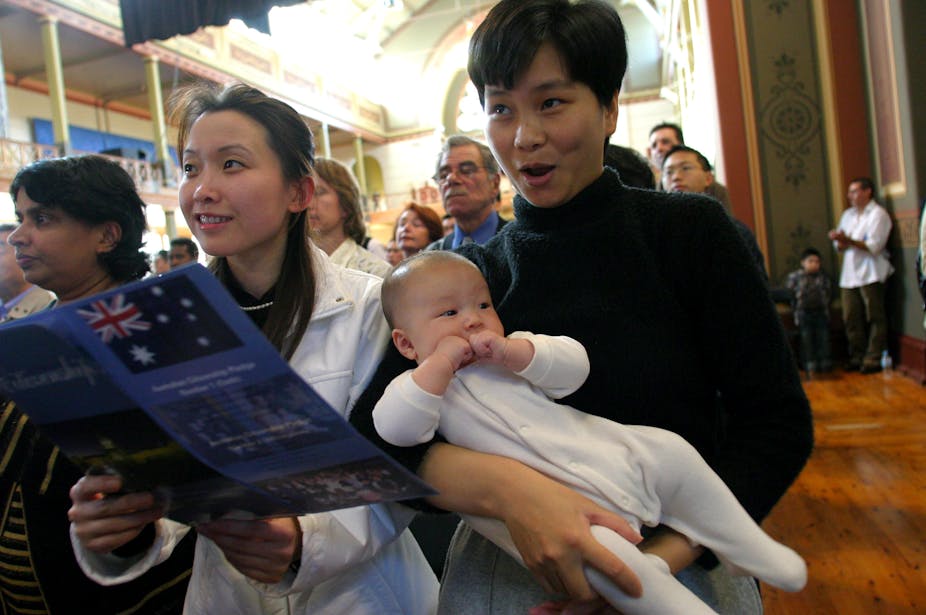Today, October 1, the Australian citizenship test turns seven. This is the official test that determines if a migrant can become an Australian citizen. It is a good time to evaluate its performance.
The test was introduced in the final days of the Howard government so that migrants and refugees could learn to respect the Australian values that are embedded in the citizenship pledge. It was feared that certain migrants and refugees did not understand Australia’s democratic values and as a result they posed a threat to social cohesion with their own “un-Australian” values.
A multiple-choice, computer-based citizenship test was offered as the solution.
The migrants that I interviewed revealed that when it comes to migrant values, successive governments do not always get it right. Most of the migrants support freedom, democracy and equality. Most of them believe that a test that can “teach” them how to become model Australian citizens. All of them want to achieve belonging in a peaceful Australia.
Where they deviated from official views is that they do not believe that these values are uniquely “Australian”. Many migrants believe that so-called Australian values are really universal human rights and that multiculturalism is the only truly “Australian” value.
Others suggested adding to the current list of official Australian values. These new values include showing respect for elders, appreciating Australia’s accessible education system and working hard to protect the rights of the Australian worker. Let’s hope that the Prime Minister and the Treasurer heed their advice.
Are all citizens not equal?
What these migrant views show is that the Australian citizenship test is succeeding in “teaching” migrants how to become law-abiding citizens who support the Australian way of life. Yet the government’s recent rhetoric suggests otherwise.
Early in August, Prime Minister Tony Abbott urged the Muslim community to join Team Australia. Two weeks later, he reiterated:
Everyone has got to put this country, its interests, its values and its people first, and you don’t migrate to this country unless you want to join our team.
Abbott was implying that if migrants do not live like “real” Australians, they pose a threat to national security. So after seven years of administering the “Australian values” test, it appears that it has not eased fears that migrant values are un-Australian.
What Abbott’s Team Australia rhetoric ignores is that the values that are prescribed for migrants wanting to become Australian citizens are not always the same values that existing citizens must respect.
The now-defunct repeal of section 18C of the Racial Discrimination Act is an example of this inequality among old and new citizens. The proposed changes to the legislation contradicted the information on freedom of speech that was included in the citizenship test as an Australian value. The citizenship resource booklet, Australian Citizenship: Our Common Bond, states:
It is against the law to try to make other people hate or act violently towards others because of their culture, ethnicity or background. (page 18)
Had the repeal gone through, migrants and refugees who want to become Australian citizens would have to accept that while they could not hate or act violently towards people who are different, existing Australian citizens, in contrast, would have had “a right to be bigots”.
Fortunately, the reform was scrapped. So once again, new and old citizens must respect the same Australian values. Yet only migrants and refugees have to prove their dedication to and knowledge of them by passing the Australian citizenship test.

Similarly, the recent debate about stripping dual nationals of their Australian citizenship if they fight in overseas wars calls into question the efficacy of the Australian citizenship test. Assuming that some of these dual nationals were conferred with Australian citizenship after having passed the citizenship test, we must then question whether the test has succeeded in preserving social cohesion and national security as it was meant to do.
It’s not about them, but about us
If we still need to urge migrants to join our team, what then is the continuing relevance of the Australian citizenship test in a constantly globalising and terror-driven world?
Clearly we don’t need a citizenship test to prove that migrants and refugees can become good citizens. Most of us would concede that a test can’t teach values. But this misses the point.
This is because the Australian citizenship test has never had the migrant as its main stakeholder. It has always been about the “real” Australian people, what Howard affectionately referred to as the mainstream and Abbott has recruited into Team Australia.
The Australian citizenship test was introduced in 2007 in order to reassure Australians that the Australian way of life could survive in a world dominated by the processes of globalisation and terrorism. Its role was and continues to be to show how the government cares for the national body, that is, for the “Australia and its people” of the citizenship pledge.

